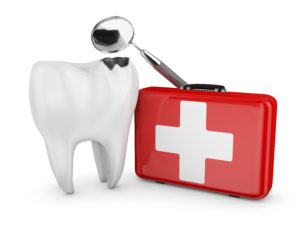 Did you know that trips to the ER for dental emergencies nearly doubled from 1.1 million in 2000 to 2.1 million in 2010? Some of these cases didn’t actually require a visit to the hospital, but when a dental emergency strikes, many people don’t know if they should seek medical care or dental care first. And, unfortunately, it’s impossible to predict when something like a toothache, jaw injury or broken filling will occur. So, when you or a loved one experience a dental emergency in McKinney, what should you do first – see a dentist, or go to the hospital? Keep reading below to find out!
Did you know that trips to the ER for dental emergencies nearly doubled from 1.1 million in 2000 to 2.1 million in 2010? Some of these cases didn’t actually require a visit to the hospital, but when a dental emergency strikes, many people don’t know if they should seek medical care or dental care first. And, unfortunately, it’s impossible to predict when something like a toothache, jaw injury or broken filling will occur. So, when you or a loved one experience a dental emergency in McKinney, what should you do first – see a dentist, or go to the hospital? Keep reading below to find out!
When Should You Go to the ER?
Although some situations require medical treatment first, you can still call a dentist afterward for any restorative work you may need. In any of the following situations, go to the hospital or an urgent care center for medical attention:
- If you think your jaw is broken or dislocated.
- If you have heavy bleeding that doesn’t subside after applying pressure for 15 minutes.
- If you have any serious facial lacerations.
- If you notice sudden facial swelling, there’s a good chance you have a serious abscess or infection. This can be very dangerous if it travels to other areas of the body, so it’s crucial to get care right away.
Tips For the Most Common Dental Emergencies
For emergencies that don’t require medical care, start by calling an emergency dentist in Oakbrook. They’ll schedule the first available appointment for you and also give you specific tips for your situation, such as:
- Knocked-Out Tooth – You’ll have the best chance of saving your tooth if you can be seen within one hour, so time is of the essence. After calling a dentist, gently rinse the tooth off (holding it only by the crown, not the root) and place it back in its socket, facing the right way. If this isn’t possible, put the tooth in a glass of milk or water, or hold it in your cheek pouch. The tooth must stay clean and moist.
- Dental Crown Comes Off – Place the crown in a plastic sandwich bag and call your dentist. Avoid using any kind of adhesive to glue the crown back on because it will make the dentist’s job harder when you arrive for treatment.
- Chipped, Cracked or Broken tooth – Gently rinse out your mouth with lukewarm water and take over-the-counter pain medication. You can also use dental wax from the store to cover any sharp edges.
- Toothache Without Severe Swelling – There are several possible reasons for this kind of toothache, so schedule a dental appointment right away and take an over-the-counter pain medication as directed in the meantime.
Dental emergencies are no fun. But by being prepared, you’ll know how to handle the situation and get out of pain as quickly as possible!
About the Author
Dr. Christine Coughlin is a general and emergency dentist in Oakbrook who combines years of experience with a gentle touch to provide outstanding care to her patients. She’s treated countless emergencies and is always able to put even the most frazzled patient at ease. If you have any other questions about dental emergencies, she can be reached via her website or at (469) 526-4040.

